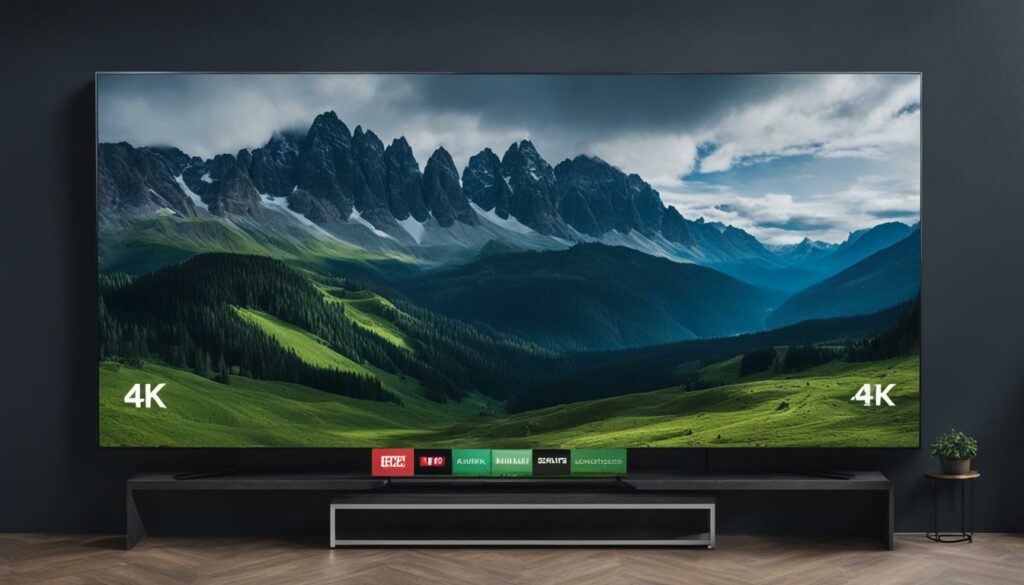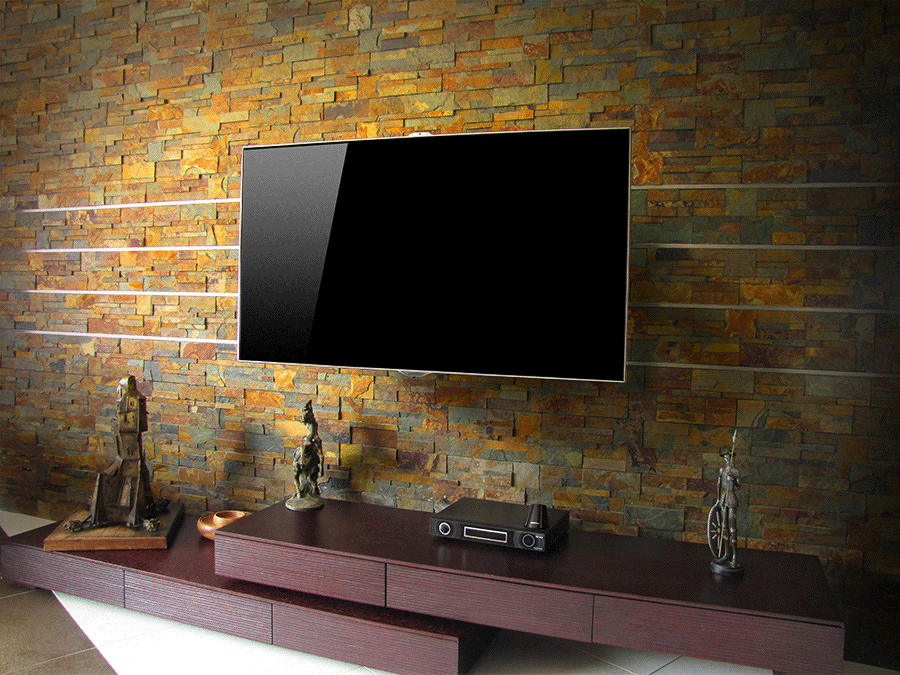The dawn of technology consistently beckons us towards sharper, more life-like screens that promise to transcend our viewing experiences. Among the latest innovations stands the formidable 8K TV — a marvel that quadruples the pixel perfection in 4K models.
As we embark on a journey through this telescopic technological leap, our visual escapades are poised to enter unchartered territories of clarity. However, it’s imperative to dissect the actual merits of 8K — not just in terms of its specifications, but how it fits into our living spaces and lifestyle.
So, is it premature to consider an upgrade, or is the allure of 8K’s promises too potent to ignore?
Understanding the Leap from 4K to 8K Resolution
The pursuit of ultra-realistic visual media has led to a monumental milestone in display technology: the advent of 8K resolution. This transformative step in the television and display market marks a shift in the number of pixels that form an image and signifies a more profound technical evolution in the media consumption experience.
The Technical Evolution: More Pixels, Sharper Images
Embarking from Full High Definition (1080p) to 4K was impressive enough, but the move to 8K resolution is nothing short of a revolution in image clarity and detail. An 8K display boasts a stunning 7,680 x 4,320 pixel array, providing a canvas that contains four times the total pixels of 4K.
This leap facilitates an unprecedented level of sharper images and fidelity that enhances the viewing experience, particularly in larger screen formats where each pixel plays a critical role in the overall picture quality. The 8K resolution detail offers a magnitude of fineness once thought unattainable in commercial home entertainment.
Visual Comparison: The Real Difference to Your Eyes
Despite the significant improvement in the quantity of pixels, the real test lies in the visual comparison and how these numbers translate into actual viewing pleasure. Whether the human eye can appreciate the uptick in pixel count depends on various factors such as screen size, viewing distance, and individual visual acuity.
It challenges the assumption that more pixels equate to a better viewing experience. While 8K resolution detail ensures a more immersive and life-like picture, the discernible difference in quality over 4K can be subtle, particularly in standard home-viewing scenarios.
Hence, the true benefit of 8K becomes more profound in specialized applications such as commercial displays or huge home theaters where the viewer can indulge in the complete visual comparison between lower resolutions and the dizzying heights of 8K sharpness.
Measuring the 8K Impact on the Viewing Experience
As the industry strives towards making 8K resolution the new standard for home theaters, the practical viewing experience becomes a pressing consideration.
Factors such as screen size and viewing distance are pivotal in how viewers perceive the ultra-high-definition detail of 8K content.
These elements can either enhance or detract from the immersive experience that 8K aims to provide.
Viewing Distance and Screen Size Considerations
Regarding screen size and viewing distance, there is a sweet spot that ensures each pixel’s contributions are ideally utilized for a powerful 8K impact.
The larger the screen, the more significant the potential benefits of 8K; however, if a screen overextends the viewer’s field of vision, it might lead to discomfort rather than an enhanced experience.
Consumers should balance these two variables to fully appreciate the 8K resolution’s sharpness without adversely affecting viewing comfort.
8K Resolution Detail and Ultra-High-Definition Experience
The allure of 8K lies in its promise to deliver an ultra-high-definition experience that surpasses all current standards. The extra pixels of an 8K TV provide a depth of detail that brings images to life, potentially transforming how we consume visual media.
However, optimal enjoyment of this clarity hinges upon carefully calibrating one’s viewing environment.
| Screen Size | Ideal Viewing Distance for 8K | Ideal Viewing Distance for 4K | Visual Impact Difference |
|---|---|---|---|
| 65 inches | 4-5 feet | 5-8 feet | Noticeable at Closer Range |
| 75 inches | 5-6 feet | 6-9 feet | More Immersive Experience |
| 85 inches | 6-7 feet | 7-10 feet | Maximum Detail Perception |
To arrive at the correct configuration for the ultimate 8K viewing experience, consumers are encouraged to consider their room dimensions and adopt a comparative approach that includes both 4K and 8K options.
Essential Technology to Support 8K TVs
As we delve into the realm of 8K entertainment, certain technological advancements are critical to harness the full potential of this ultra-high-definition experience.
Notably, significant support technology for 8K is emerging, enabling viewers to immerse themselves in the unprecedented clarity and detail that 8K content provides.
The Necessity of HDMI 2.1 for Full 8K Performance
To enjoy the full spectrum of 8K capabilities, HDMI 2.1 is a non-negotiable element. This latest version of HDMI technology is ingeniously crafted to handle the enormous data loads that 8K content demands.
Unlike its predecessors, HDMI 2.1 supports up to 48 Gbps bandwidth, rendering it essential for transmitting 8K signals at 60 frames per second, practically bringing still images to life.
High-Speed Internet and Streaming: Preparing for 8K Content
In the era of digital streaming, preparing for 8K content inevitably means equipping oneself with high-speed internet. The infrastructure must follow suit as viewers anticipate the advent of streaming platforms offering 8K content.
A robust and stable internet connection, preferably leveraging the capabilities of Wi-Fi 6 or 5G technology, becomes indispensable for streaming the massive files associated with 8K media without buffering or quality degradation.
The critical support technology for 8K encompasses connectivity and data transfer speeds and focuses on consumer readiness to adapt to this innovation. While the market races to meet the technical requirements of 8K, it is equally essential for audiences to understand and prepare for the technological shift that 8K brings into home entertainment.
8K TV Advantages: Assessing the Visual Benefits
When discussing the advantages of 8K TVs, the spotlight often shines on their transformative visual benefits. These advanced displays elevate the viewer’s experience to an ultra-high-definition experience unprecedented in prior television formats.
As the frontier in home entertainment, 8K TVs command attention for their incredibly high resolution, bringing heightened detail, depth, and image density. These elements converge to sculpt a viewing environment that feels more immersive and true to life than ever before.
Can viewers appreciate the finer aspects of 8K resolution, or does the omnipresent quality of 4K technology already saturate the average consumer’s demands? To address this, one must consider the available 8K content, which utilizes the total capacity of 8K displays to produce richly textured and staggeringly clear visuals.
- Detail so sharp that the line between the screen and reality blurs
- Depth that adds a new dimension to on-screen content, inviting viewers into the scene
- Image density that prevents any discernible pixelation, even on the most expansive screens
Evaluating the 8K TV Market: Availability and Price Point
The burgeoning 8K TV market offers a cutting-edge visual experience but comes with availability and price point considerations that impact consumer adoption.
Faced with the anticipation of an unparalleled viewing experience, prospective buyers must navigate the factors influencing the market’s trajectory and their own investment decisions.
Comparing Costs: 8K TV Investment vs. Current 4K Models
Consumers encounter a vast financial gulf when comparing costs between 8K and 4K televisions. 8K TVs are priced significantly higher, often reflecting advanced display technology and a market that has yet to scale. This price disparity influences buyer behavior, as many still opt for the more affordable 4K alternatives.
The Future of 8K TVs: Pricing Trends and Consumer Adoption
Interpreting the future of the 8K market in terms of pricing trends and consumer adoption is a complex endeavor. The price elasticity for these advanced TVs and the rate at which manufacturing costs decrease will be critical in determining whether 8K TVs become mainstream or remain a niche luxury product.
| Brand | 4K TV Model | 8K TV Model | Price Difference |
|---|---|---|---|
| Samsung | QLED Q60A | QLED Q800T | $2,000+ |
| LG | NanoCell 85 Series | Signature ZX | $4,000+ |
| Sony | Bravia X900H | Bravia Z8H | $3,000+ |
| Vizio | P-Series Quantum | – | – |
As major players like Samsung, LG, and Sony expand their offerings, the 8K TV market landscape evolves. The table above exhibits the prevailing price differences, underscoring the investment consideration for consumers.
Vizio, for instance, is currently focusing on the 4K segment, highlighting a notable contrast in market availability and approach.
Current State of 8K Content: Is There Enough to Watch?
When considering the leap to the next frontier of visual fidelity—8K resolution—the question often arises: is enough 8K content available to justify the investment?
Let’s delve into 8K content availability across various entertainment mediums to gauge whether these cutting-edge displays can elevate our viewing experiences.
Streaming Services and 8K: The Road Ahead
The promise of 8K streaming from significant streaming services remains a future consideration for the most part. Services like Netflix, Amazon Prime Video, and Disney+ have begun experimenting with higher-resolution content, yet the offerings in 8K are sparse.
The immense data requirements for streaming 8K also mean that consumers will need exceptionally fast internet connections, which may not be available or cost-efficient.
Although the roadmap for 8K streaming looks ambitious, the widespread adoption and availability of 8K content on these platforms will not materialize immediately. As the bandwidth and infrastructure improve, we may see an increase in 8K offerings, but for now, 4K remains the more accessible high-definition standard.
The Reality of 8K Gaming and Entertainment
Gaming industry giants like Sony and Microsoft have hinted at the possibility of 8K gaming with their latest consoles, the PlayStation 5 and Xbox Series X. However, the reality of 8K gaming does not yet match the excitement of these announcements.
Most games currently do not support 8K resolution, and the intense computational power required to run games at this resolution is still beyond the capabilities of current-gen hardware for most titles.
Apart from gaming, the broader scope of entertainment experiences—virtual reality or live sports broadcasting—has also not met 8K standards. The industry produces content predominantly in 4K, which maintains its position as the standard for the high-definition viewing experience.
Consequently, the vision of an 8K-dominated entertainment landscape remains on the horizon, waiting for technology and content production to align.
Is an 8K TV Upgrade Right for You?
Embarking on the upgrade journey to an 8K TV is a significant decision that demands scrutiny of several pivotal aspects, including technological enthusiasm, media consumption patterns, and financial considerations.
The allure of joining the vanguard of ultra-high-definition visuals is tempered by the pragmatic aspects of the availability of native 8K content and the efficacy of such an investment.
Striking the delicate balance between desiring the sharpest possible picture and ascertaining the viability of an 8K TV upgrade necessitates a perceptive 4K vs. 8K comparison.
When considering content, 4K has become the industry’s production standard, leading many to question whether an immediate shift to 8K is pragmatic or premature.
- Consumer Demand for Cutting-Edge Technology
- Content Consumption Habits
- Financial Budget Constraints
- Longevity and Future-Proofing the Home Entertainment System
To stay ahead of technology curves, future-proofing one’s entertainment center by adopting 8K may seem a no-brainer. However, the tech-savvy consumer might ponder whether present-day content and broadcasting infrastructure match the capabilities of 8K TVs to justify the transition.
4K vs 8K Comparison: Is the Difference Worth It?
In today’s rapidly advancing technological era, the 4K vs 8K comparison has sparked considerable debate among consumers and experts alike. With 8K resolution promising unprecedented clarity and detail, it stands at the precipice of becoming the new standard in visual media.
Yet, the pertinent question remains—do these advanced specifications translate into a tangible improvement in viewing experience, and is it enough to warrant its longevity in a market still dominated by 4K content?

Clarity and Detail: Do More Pixels Equal a Better Picture?
Enthusiasts who revel in the latest technological advancements may quickly point to the superiority of 8K in terms of its raw pixel count. However, this clarity and detail must be scrutinized within the context of everyday use.
Just because a screen can display a denser image does not inherently mean the human eye can discern these added details from a typical living room distance. The consumer must consider whether their environment and content can fully exploit the 8K potential.
Investing in Longevity: Will 8K Become the New Standard?
Committing to an 8K TV is an investment in what some might call the new standard of home entertainment. However, the transition toward this coherence is gradual and fraught with content creation, broadcasting, and delivery uncertainties.
The pace of adaptation and the readiness of the market are equally as significant as the technological prowess of 8K displays themselves. For now, the longevity of 8K TVs as the industry pinnacle is yet to be a closed case, leaving consumers to strategically ponder their next move in upgrading their viewing systems.
The Current State
The landscape of television technology is constantly evolving, with 8K resolution being the latest frontier, offering an ultra-high-definition experience that eclipses previous standards. While the benefits of 8K are clear in terms of pixel density and potential for image clarity, these advantages arrive with considerable caveats.
The current state of content availability, the required investment for discernment of quality differences, and the substantial costs associated with 8K TVs present significant barriers to widespread consumer adoption.
For those keenly observing the future of entertainment, it is apparent that 8K TVs hold a promise of advancement but also face the challenge of a nascent ecosystem still building its foundation.
Given the pace at which technology progresses, it is foreseeable that these issues may diminish in time; yet, at this juncture, 8K remains a technology poised on the brink of potential rather than a present-day necessity for most viewers.








